Read in: Français (French)
A family’s travelogue from Phnom Penh to Paris and back
DAY 1
Control point 1
Our stopover is Guangzhou, the capital of Canton province, a former terminus on the Silk Road. Just a stone’s throw away are industrial Shenzhen and Hong Kong, where part of my family has been exiled. A-kong,1 my father, will be visiting them later in the year. For the moment we have another trip to make: one that will take us back forty-seven years, before that long episode in France that covers almost the whole of my life, but which for him was a long swing to the other side of the world.

Where there’s an airport, there’s security, and where there’s China, there’s screening, so here we are at the checkpoint at Baiyun International Airport, where austere officials are checking that we’re not carrying anything suspicious. We go through the scanner first, and A-kong takes his time. When the diaphanous image of his suitcase’s entrails finally appears on the screen, the agents are surprised to see quite clearly a thirty-centimeter knife, lying peacefully alongside twelve boxes of Doliprane (paracetamol) 1000mg, one hundred and eighty COVID masks (which he will later offer to my cousin) and eight camera batteries — for A-kong suffers from a rather severe scopic compulsion. A conversation in Mandarin ensues between the agent and my father, who hopes to convince the woman not to confiscate his « fruit knife ». Meanwhile, while my wife Insa questions the reliability of Luchthaven Schiphol’s security service (we’d flown from Amsterdam), my daughter Elly rolls her eyes, my son Robin pretends to look at his smartphone (without a network), and I watch my father adopt a familiar posture: a man of good faith imploring clemency from his next superior. This time his plea has little effect. But I know it has worked before — at least once.
« No, son, in the jungle, the food is you. »
It was forty-seven years ago, in a sweet potato field on the edge of the jungle. A few days earlier, the Khmer Rouge had entered Phnom Penh as liberators, then started shooting at everyone. Like many others, my family had had to flee, leaving almost everything behind, and was starving on the long road to Vietnam. Later, in my childhood, I well remember interrupting my father when he told me about this journey through the jungle:
— « But Dad, there’s food in the jungle: bananas, mangoes! Just like in Walt Disney’s cartoons. »
— « No, son, in the jungle, the food is you. »

So, after hours of walking, my father spotted a field. We were so hungry that he decided to leave the protective envelope of the jungle behind and go out into the open to dig up some edible tubers. Unfortunately, he was caught in this illegal act by a young armed revolutionary. A-kong is caught red-handed, or dirt-handed. I imagine asymmetrical exchanges in Khmer, his earthy hands clasped in a posture of prayer, his gaze imploring mercy from the defender of a new, resolutely agrarian society. « I’m sorry, I’m sorry. » A-kong sometimes recalls the scene just to teach me a practical lesson: « you have to keep on crying, explain the hunger, the exhausting walk, the family hidden in the jungle. Make him understand our human misery. » The young boy answers: « It’s ok, this time. »

Control point 2

Ballet royal by Doan Van Ha
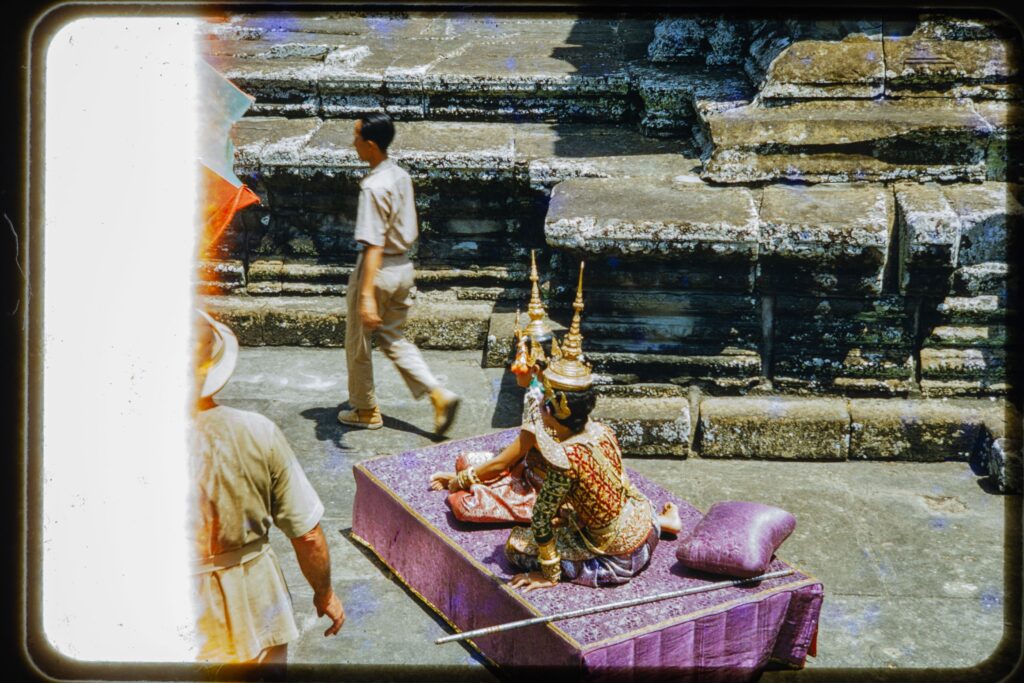
The rolling suitcases echo timidly in the arrivals hall at Phnom Penh airport. Just a few more meters before the anxious moment of passport control, the last but most difficult of all. For a family that was decimated during the overthrow of Prince Sihanouk in 1970 and then under the Khmer Rouge regime in 1975, identification with the local authorities is no mere formality. It’s true that international bodies have since set up « Extraordinary Chambers » to judge the crimes of Democratic Kampuchea.2 It’s true that every passing day is helping to mend the past, and that Google Street View in particular helps remind my father that his forsaken world does in fact still exist. But there’s still one big question we have to ask ourselves at this moment, a question that has been haunting my father’s mind and mine for quite some time: should un petit billet, a bit of cash, be slipped into the passport or not? This lowly material question, as the trip loomed, grew into a touristic-ethical dilemma which we debated at Melinda’s, the Cambodian restaurant in Paris that has been a cultural home base for the last forty years.
— « You put a ten-dollar bill in your passport and the officer asks you no questions, » says Sylvain. Sylvain, like thousands of Cambodian refugees in France in the 70s, changed his first name when he became a French citizen, a practice that is much less widespread today. In my family’s case, Ché-Hung (my mother), Té-Xuyen (my father, AKA A-kong) and Chi-Hong (me) be came Martine, Julien and Patrick (after Patrick Duffy, who played Bobby Ewing on the TV series Dallas).
— « But do you have to? »
— « No, but it’s the easy way. » Easy is a pretty convincing argument for bribery, given our situation, but then it’s goodbye principle and hello compromise.
— « No, it’s corruption, I don’t want to. »
— « Pfff », says A-kong, shaking his head. « You don’t know anything, do as you please. »

That’s what’s on my mind as I set foot once again on the soil of my native land for the first time since 1976. At the checkpoint, the officer holds out his hand without looking at me. I give him my French passport, maroon-bordeaux, and I think to myself: No, no ticket, my friend. Instead, a rather special visa. Not an ordinary T visa for tourist, but an authentic K visa for Khmer.
— « Hmm, K visa. » (It means I was born in Cambodia or have a Cambodian parent. No expiry date, in other words, it’s valid for life.)
— « Yes » (To obtain it, you can either present various certificates to the embassy, or simply have a Khmer name and speak the language.)
— « Do you speak Khmer? »
— « No, I’m sorry. »
Silence. Maybe he’s upset that he didn’t get his baksheesh? Maybe he’s going to ask me to follow him? Maybe my family’s history is on his computer screen, and he knows something about A-kong? The agent looks at me with his dark eyes and says in an official but warm tone, « Welcome home Patrick. »

DAY 2
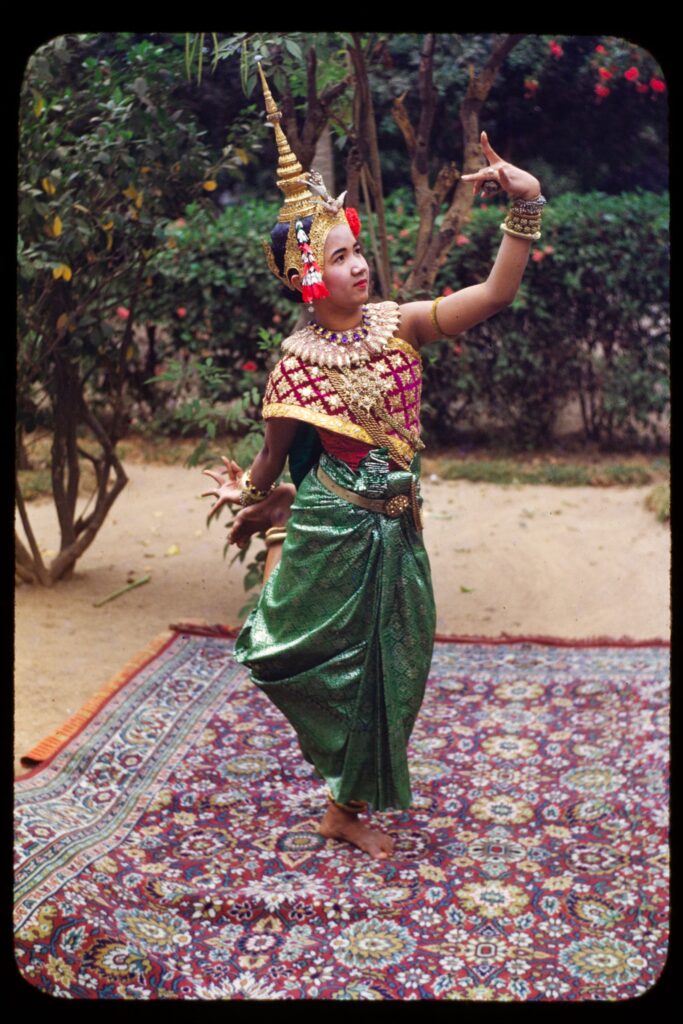
Ballet royal by Doan Van Ha
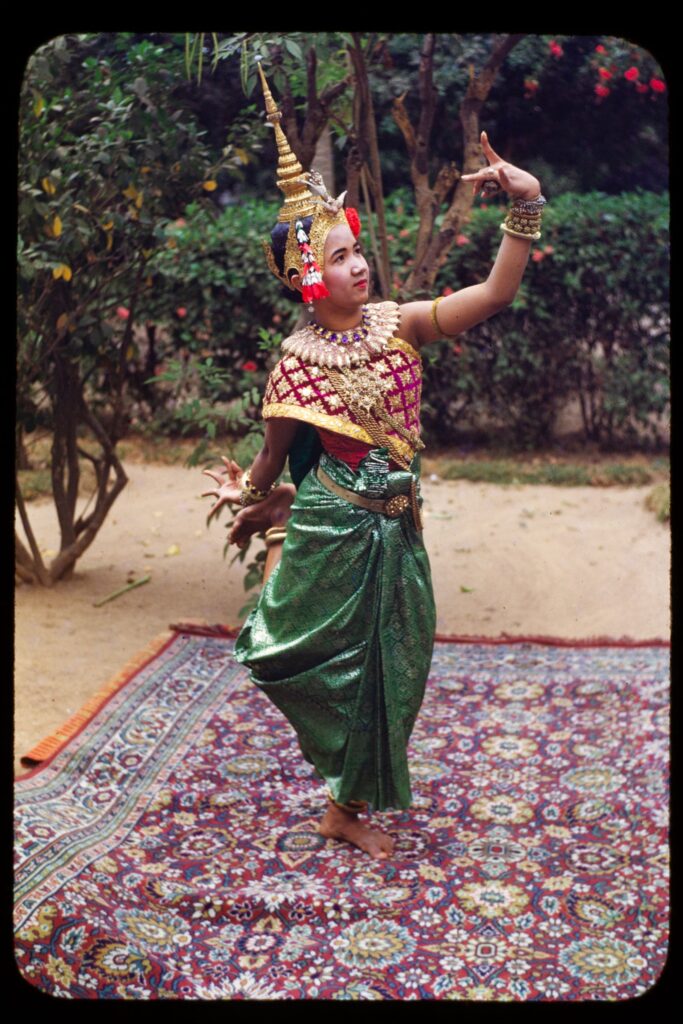
We woke up « a few steps from the Royal Palace and Wat Botum (the Royal Pagoda) ». (The hotel, by its own description, is « a complex of four historic buildings, one of which is said to have been the private residence of Queen Mother Kossamak. » I had covered our bases pretty well in anticipation of the vicissitudes that awaited us outside this golden enclosure. The exhausting strolls through the hot, muggy air, the dizzying noise and smells, the inevitable tourists — everything was, if not dreaded, at least expected. Well, here we are, we are going to take the plunge but not without a net. We set out to get that little thing you can’t do without: a SIM card. A-kong follows us with his quick, silent steps. He has some experience with situations where you have to take essential things with you, having had to pack the most difficult luggage of his life on 17 April 1975.
Le temps était à la survie. Survival consumed the moment.
Five days earlier, the Americans had evacuated their nationals, while the headquarters of the Khmer Republic — the US-backed dictatorship, soon-to-be overthrown — relocated to the Thai border. Civilians, meanwhile, waited helplessly to learn their fate. The new masters gave the order to empty Phnom Penh of its inhabitants. Like thousands of others, my family had three days to obey the order — to choose, in other words, what to take and what to leave behind. My maternal grandparents’ sporting goods store, above which we lived, my paternal grandfather Ha’s photo studio, the precious rolls of film, the paintings. Le temps était à la survie. Survival consumed the moment: make our way through the jungle, avoid the roads controlled by the Khmer Rouge. It was going to be a long walk — 123 km or 2h27mn by car, Google Maps tells me now — to reach Vietnam.
— « You have to think, think about what’s really important when you’re in the jungle », A-kong told me when recalling this episode. There’s no shelter, so you need a tarpaulin and ropes, lots of ropes. Clothes, good shoes, containers, a small axe, medicines that you have to hide well — in the hollow handles of the cart for example.
There were a thousand things he would have liked to take along, but he had to make do with the essentials, as options are limited when traveling on foot with a three-year-old (me) and a grandmother.3
— « You know, I’d asked your mother to go and get some fishing hooks downstairs, from the store. » (Indeed, if you draw a straight line from Phnom Penh towards the Vietnamese border you can see that it is parallel to the Mekong River.) « She’d only taken a box of ten. Little did we know then that during our escape we’d be able to trade each of those hooks for a little bag of rice. I still think about it, you know. There was a whole box of them in your mother’s parents’ store. »
— « Yeah, I know, Dad, it’s okay. »

A-kong doesn’t like to talk about this episode in his life, but every now and then, a situation throws him back into it. So he shares a few lessons he learned along the way. When we’re walking by a river, there’s a good chance he’ll remind me: « You see, to cook rice you have to swim and fetch the water from the middle of the river, not from the bank because it’s dirty. » Sometimes I think he’s stuck in survival mode.

DAY 3
The tuktuk driver has dropped us off at a crossroads halfway along the route. There’s a problem with the engine of his Honda and, on the side of the road, an impromptu repair begins. A jet of petrol sprays the man’s face. Moderately optimistic, we wait in the shade of an exotic tree, watching the incessant flow of motorcycles. Some teenagers wearing high-school uniforms stop at a red light. They chat, carefree, and smile at us from afar. Today, A-kong will be reunited with his two childhood friends.
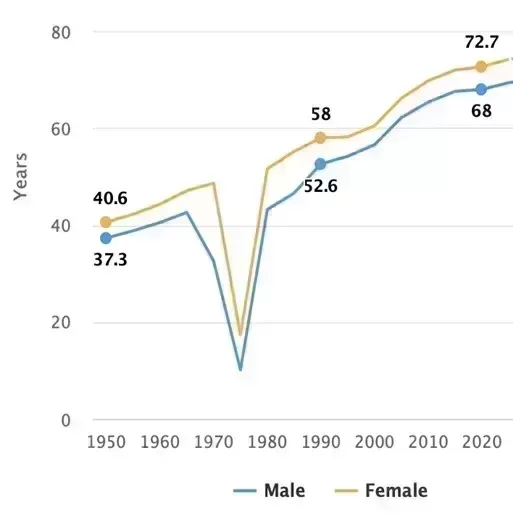
Life expectancy in Cambodia from 1955 to present. In 2020, Cambodia had just 5.3 percent of the population aged over 65, with 0.7 percent aged over 80 (source: ESCAP)
We finally arrived at the address, located in a new district on the outskirts of Phnom Penh. Everything is new and modern. You’d think it was an alleyway in a residential area of the neuf quatre, a suburb south of Paris. Two frail-looking elderly men wait for us on the doorstep, the smile of l’ami retrouvéon their faces.4 Crooked handshakes, gentle pats on the back. We respectfully enter the home of Lim Khun, the eldest.
It’s become a myth: the elegant man who ran the oldest photo studio in Phnom Penh.
— « He used to be the class rep, » A-kong tells me. The three of them had found each other on Facebook after decades spent in different corners of the world. Lim Khun remained in Cambodia (he was unable to escape the war), the second went to Hong Kong, my father to Paris. Old black-and-white class photos appear on smartphone screens. In one of them I recognize my father’s smiling face. He must have been seventeen, and looks as happy as he is today. A-kong gives his friends small gifts, an LED light bulb and a plastic Eiffel Tower.
We all go for lunch nearby, at a fried-chicken fast-food joint in the neighborhood’s new shopping mall. Insa, me and the kids retire from the table, leaving the three octogenarians to reminisce about high-school days and friends. The air is cool, almost cold. A few steps away, there’s an upscale supermarket, where young, well-behaved shop assistants greet us.

DAY 4
In front of number 4 Preah Norodom Boulevard, the new owner of the premises — a rundown hair salon — listens to my father, chewing his lips. Nothing on his broad face gives away his thoughts as A-kong tells him the story of our family and the photo studio of his father, my grandfather, Doan Van Ha. I’ve heard this story so many times that it’s become a myth: the elegant man who ran the oldest photo studio in Phnom Penh, where the dignitaries of Khmer society came to have their portraits taken, as did actresses, singers and dancers from the Royal Ballet. My grandfather — a painter in his spare time, a professional photographer and an inveterate gambler — was a mysterious and paradoxical figure for me. Through the snippets of A-kong’s tales, of royal delegations and other balls, I could sense a contrary streak, too. In fact Van Ha was sympathetic to the communist movement, like many artists in the 1960s. The high point of this « oral tradition » was the time Van Ha covered the arrival of General De Gaulle in Phnom Penh in August 1966. De Gaulle was on a diplomatic world tour that took him to France’s former colony, which had become independent in 1953. Prince Sihanouk was hoping for France’s support in Cambodia’s neutrality in the Cold War between the United States and China; he had the streets of Phnom Penh decorated in French colors for the occasion. Alas, the visit did not result in the help he had hoped for, and the rest is history. A-kong told me the story many times:
— « Your grandfather was in the motorcade in front of the state limousine. In the rush of photographers, the cover of the 16mm reel had fallen off the camera onto the road. He had to jump out of the vehicle to pick it up and quickly get back on board. It was really stressful, but he had no choice. »

Wong Kar-Wai’s film In the Mood for Love, in one of the final scenes, shows archive footage of De Gaulle’s arrival. I find myself looking for my grandfather in the crowd. Or is it an excerpt from Grandpa’s own reel? Maybe it never happened. A-kong doesn’t think there’s any trace left of the films or photos.
— « The Khmer Rouge destroyed everything, he said. There’s nothing to find. »
That’s it, my father has finished telling the story and his interlocutor is pretending to think. Finally, he says in Khmer:
— « Yes, I remember Photo Royal. It was here before us. »
My old man then turns to me and says in a relieved tone:
— « It’s okay, he remembers. »
A little later, we’re off, having scooped up some earth with a small spoon. It’s going to rain.

DAY 7
We had a large family in Cambodia, nine brothers and sisters on my father’s side and seven on my mother’s, not to mention old aunts and uncles, grandfathers and grandmothers. All of them left or were killed during the war, but nowadays some of us are returning, looking for our roots — or for a bargain. That’s what my wealthy aunt did, coming back from Hong Kong after the war to buy houses in Siem Reap. Siem Reap means « crushed Siamese » in homage to the ancient Khmer kingdom’s victory over their long-standing adversaries: the Siams (modernday Thailand). Today, Siem Reap is Cambodia’s second-largest city, boosted by the tourist appeal of the « Angkor Monumental Complex » and its majestic temples carved out of the jungle.

We arrived there yesterday for a long seven days — enough, I told myself, to find our bearings and « see everything ». On Sylvie’s advice, I had set up our base in a family guesthouse opposite an elementary school from which you can hear the laughter and singing of Khmer children. Sylvie is the granddaughter of my elderly aunt, with whom we had fled through the jungle. She’s my « little cousin » and we’re going to visit her today. Of all the living members of our family, Sylvie is the only one to have returned to live in Cambodia — a journey against the grain — and to have started a family there. At the sight of my father, she takes his hands and begins to cry.
She remembers me as a teenager playing video games and watching TV. I remember a very well-behaved little girl holding the loving hand of her grandmother who was an excellent ping pong player. At the time, they lived in the same dilapidated building as my mother, 1 rue Édouard Robert, in the 12th arrondissement of Paris. My parents divorced when I was eighteen; I lived a stone’s throw away with A-kong, and with my cousin Manu. It was a small world started from scratch.
Some of us are returning, looking for our roots — or for a bargain.
Sylvie’s boys are playing with their presents, two Playmobile motorbikes so neither gets jealous. A-kong, eternally a big kid, unwraps a K2000 (Knight Rider) remote-controlled car. The happy living room opens onto a covered terrace. Sylvie’s husband, Sopheap, returns from his job interview with the company administering the new Siem Reap-Angkor international airport. He’s been hired! No matter the fifty kilometers journey or the roads not yet built, the whole family is happy with this new start, after the long desert crossing that was the COVID pandemic.
A tepid night envelops us and we dine on the terrace, where the drafts bring a little freshness. As the children drift off to sleep, we chat about our plans, how to visit what, on foot or by elephant, as in the old days. Maybe we will push a little further north, to the temple of Preah Vihear, an architectural and cultural jewel that has accompanied Cambodia’s history for twelve hundred years. Built on top of a hill in the Dângrêk Mountains, at an altitude of over five hundred meters, this sanctuary is a must-see but A-kong argues against it. In the tuktuk on the way back, he gives one of those vague looks.
— « You shouldn’t go there because it’s too dangerous, too close to the Thai border. »
— « But why? »
— « It’s because of your grandfather’s movies. »
— « But that’s the past. Nobody knows… » Even tonight, I couldn’t convince him, because up there, in the north, there’s like a mental electric fence he doesn’t want to go near. I turn to Elly who reflects on the day and tells me: « It was such a nice day on this side of our family … because we don’t know anything about you, Dad. »

DAY 17
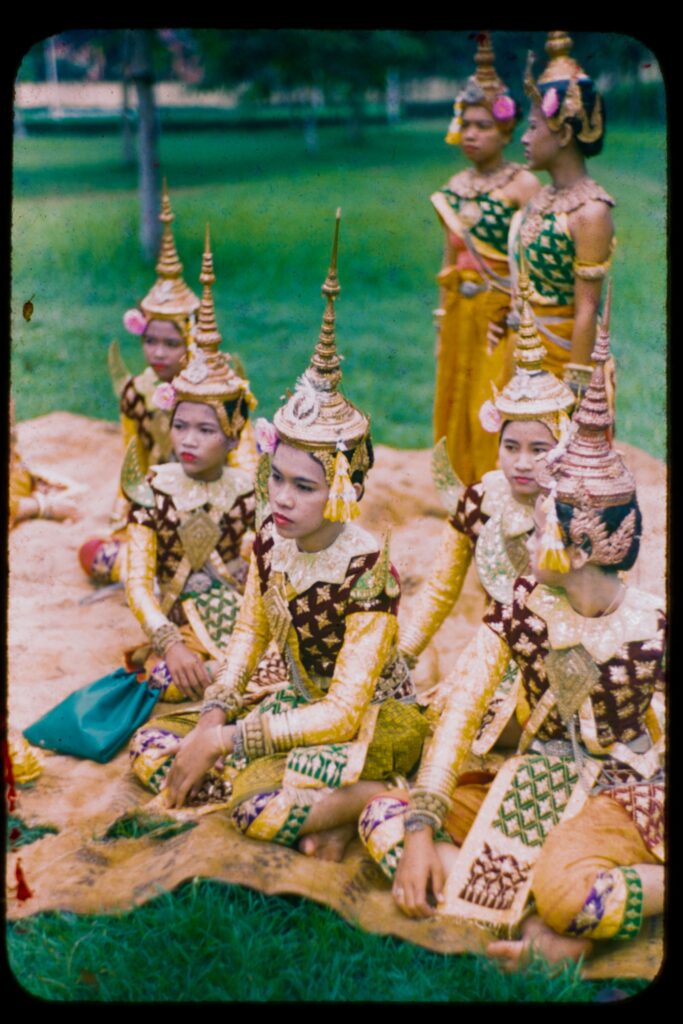
Ballet royal by Doan Van Ha
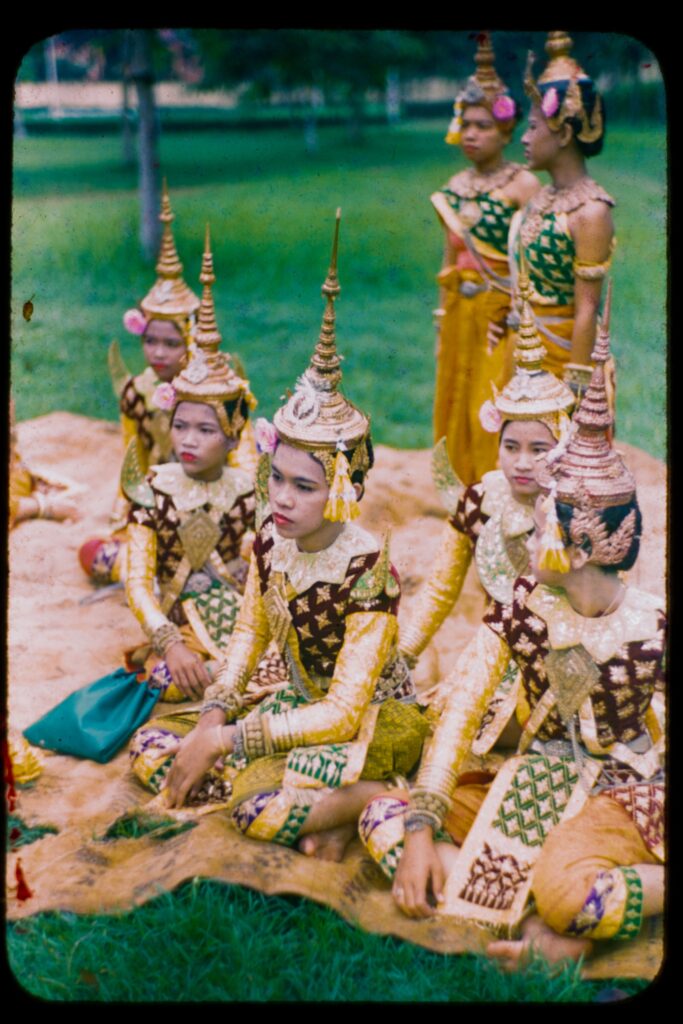
Our trip is about to come to an end, with a stopover in Kep and its famous blue crab market on the shores of the Gulf of Thailand. The tails of typhoon Doksuri have been drenching us daily since we arrived, but today is the truce and we’re celebrating A-kong’s birthday. « Where’s the Ferrari? » he asks after carefully unwrapping his presents, and then, as it happens dozens of times a day: « wait, let’s take a photo. » « But who’s going to look at these photos A-kong? »

Sothy’s Pepper Farm is located inland. It grows mangoes, papayas and, above all, pepper: the famous pepper de Kampot AOC. As with fine wines, the latter develops a flavor that is specific to the terroir on which Piper nigrum grows, a tropical liana from which pepper is made. A-kong listens half-heartedly as our host tries to introduce us to the subtleties of this other black gold. The old man waits for the moment when he can indulge in this exercise of reconstructing the past, telling the story of our family once again. Today, it’s a special episode that will rub up against the present.
Today, A-kong is talking about Preah Vihear with pride, a switch from the ominous discourse ten days ago. The fact is, for generations, Thailand and Cambodia had been locked in a border dispute over who owned the temple of Preah Vihear and its surroundings. Built between the ninth and tenth century AD, the temple, like other parts of Cambodian territory, changed hands as the Khmer Empire slowly declined. Absorbed by the Siamese expansion, then ceded to the French colonial power, reoccupied by the Thaï (modern Siam) army as soon as Cambodia became independent, Preah Vihear is the symbol of the fight of the young republic for its sovereignty. On 15 June 1962, the International Court of Justice (ICJ) in The Hague handed down a final verdict in favor of the Khmers. Among the documents presented in the file were, according to A-kong, films made by my grandfather Ha for the Cambodian Forestry Agency. In gratitude for this service to the nation, he had received a pin by mail. This and his other work for the government probably cost him his life when army chief Lon Nol overthrew Prince Sihanouk in 1970.
In gratitude for this service to the nation, he had received a pin by mail.
As we leave the farm’s shop, our host comes up to us with two bags of black pepper, and says in a solemn tone: « This is for your dad from me. He’s a good man. » A-kong has already gone ahead. I watch him discreetly fiddling with the solar cooker that was set up at the entrance of the farm, checking out the underside of big metal dish.

DAY 20
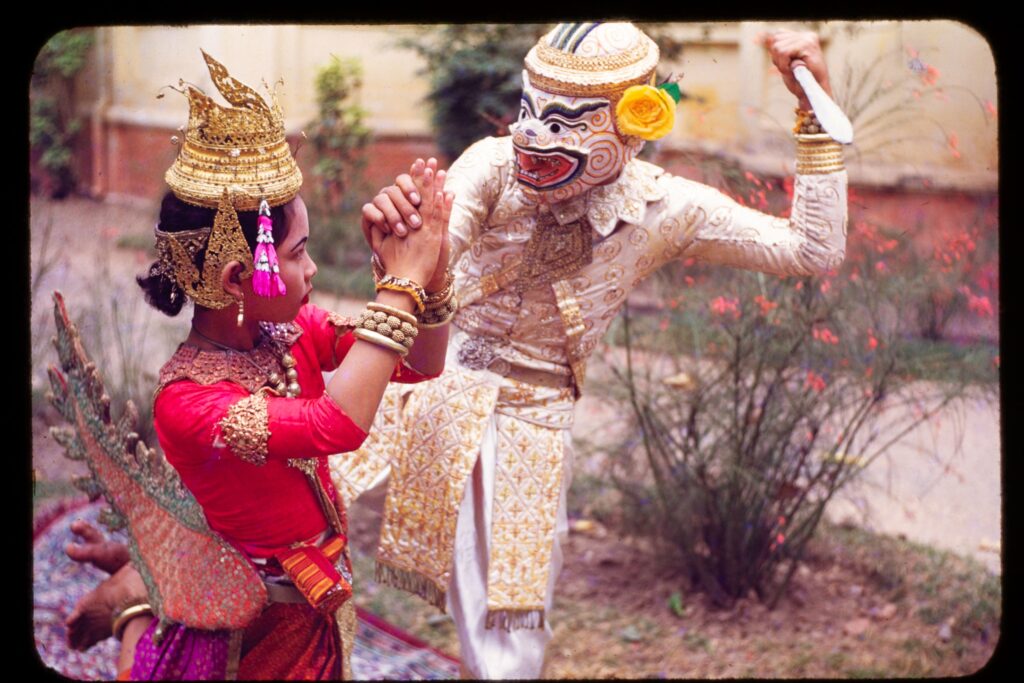
Ballet royal by Doan Van Ha
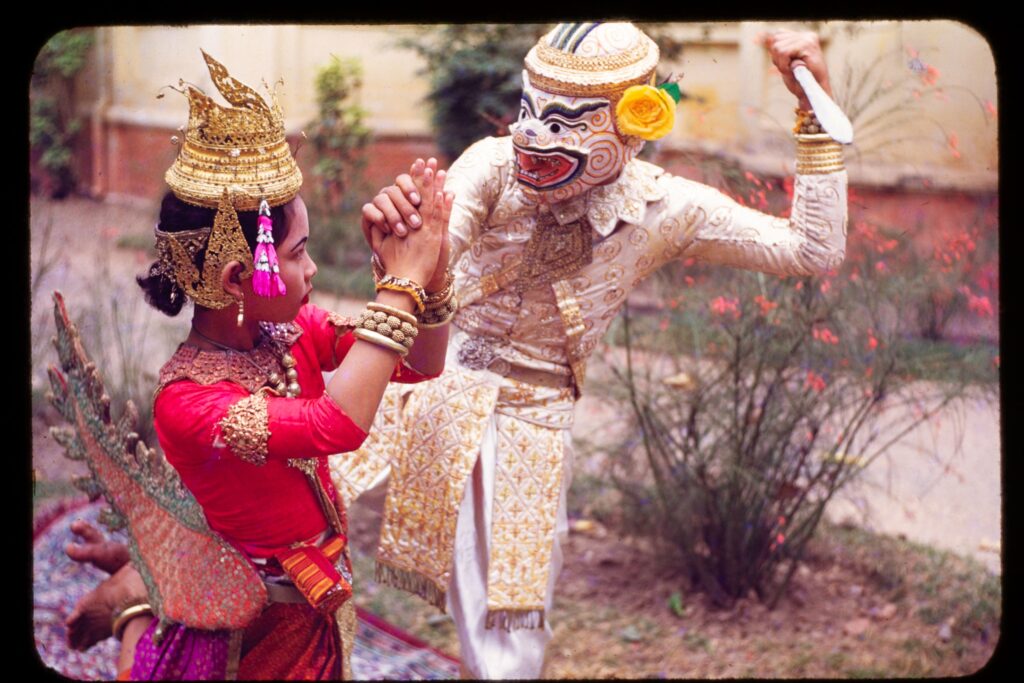
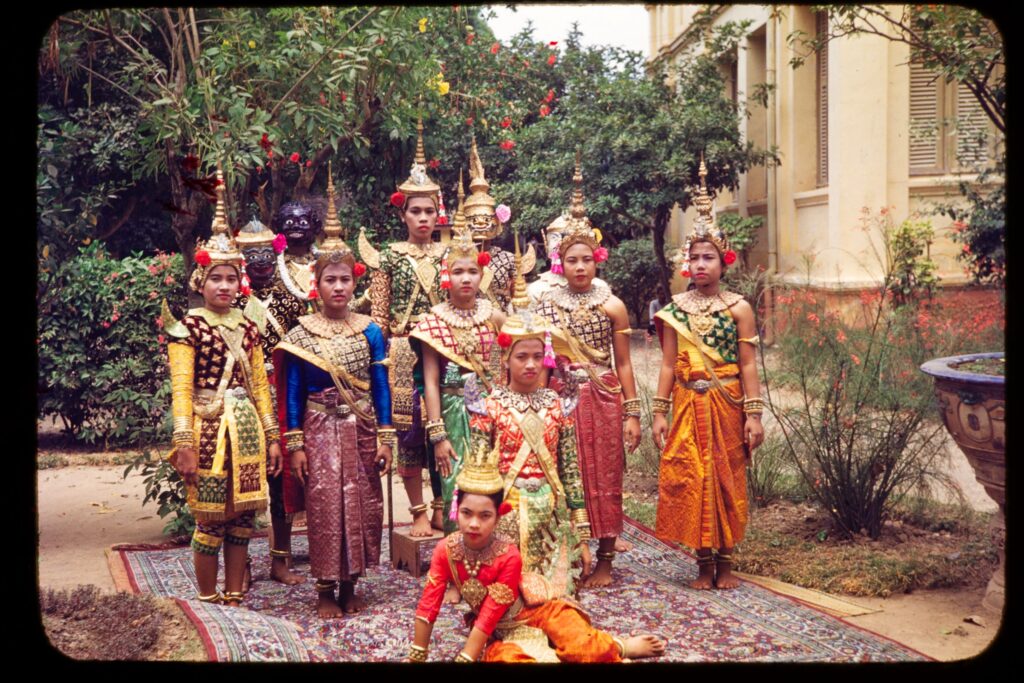
We’re back to Phnom Penh with the melancholy of those who know they’ll soon have to leave. In exactly two days’ time, I’ll pass the airport checkpoint and see the little red sign that tells travelers, « You don’t have to offer money » — an euphemism for bribing — but before that, I’ve planned one last excursion, one last attempt to put our family puzzle in order.
A-kong went to France with his own treasure trove of apsaras in his pockets.
Under the white midday sun, our tuktuk winds its way up Preah Norodom Boulevard and stops in front of the SOSORO Museum, Cambodia’s « museum of economy and money ». Inside, a new exhibition revealed that the mighty civilisation of Angkor (AD 802-1431) flourished without recourse to the omnipresent — omnipotent — instrument of payment, savings and accounting that we have today.
Normally I would lag while the others speed through the rooms, but this time I don’t dawdle, because for me and A-kong the highlight of the visit is outside, in the annex. It was during the search online for pictures of the royal family (to see if the name of my grandfather would pop up) that I came across the museum’s temporary exhibition, King Sisowath’s Journey to France, a Mutual Revelation. It recounts the Khmer suzerain’s 1906 trip to France, which triggered an immense « wave of fascination and sympathy » among the French. Freshly crowned at the time, he embarked on a journey lasting several weeks aboard a steamship, taking with him a veritable little court: princes, ministers and mandarins, ladies, maids and cooks, plus the royal ballet troupe.
The first public appearance of the ballet produced a profound shock. The music, the choreography, the gestures were at odds with Western ballet. An essential dimension — the intercession between the earth, the King and the celestial powers — escaped the profane. The mysterious art nevertheless had a great power of fascination.5
— « Son, look, it’s the apsara dancers from the Royal Ballet. »6
A-kong’s gray eyes squint to better discern the graceful silhouettes on the postcards. I can feel the fascination in his voice, not that of the journalists of the time, but that of a boy whose father photographed this prestigious corps de ballet in the 1960s, before everything fell apart. Today, it’s the meeting of two parallel lines, united for the time of a journey into the past. Like King Sisowath with his troupe of dancers, after all, A-kong went to France with his own treasure trove of apsaras in his pockets. A few photos my grandfather made of this Royal Ballet escaped the destruction, survived the jungle and multiple moves. My father kept them in the form of a collection of slides carefully arranged in a small yellow Kodak box, which he never parted with. On many occasions, I tried to persuade him to entrust them to me to have them printed. « No, if I lose them, that’s it. They’re all I’ve got left of him, » he replied each time in a worried tone. Elly digitized them for the first time this year.

DAY 22
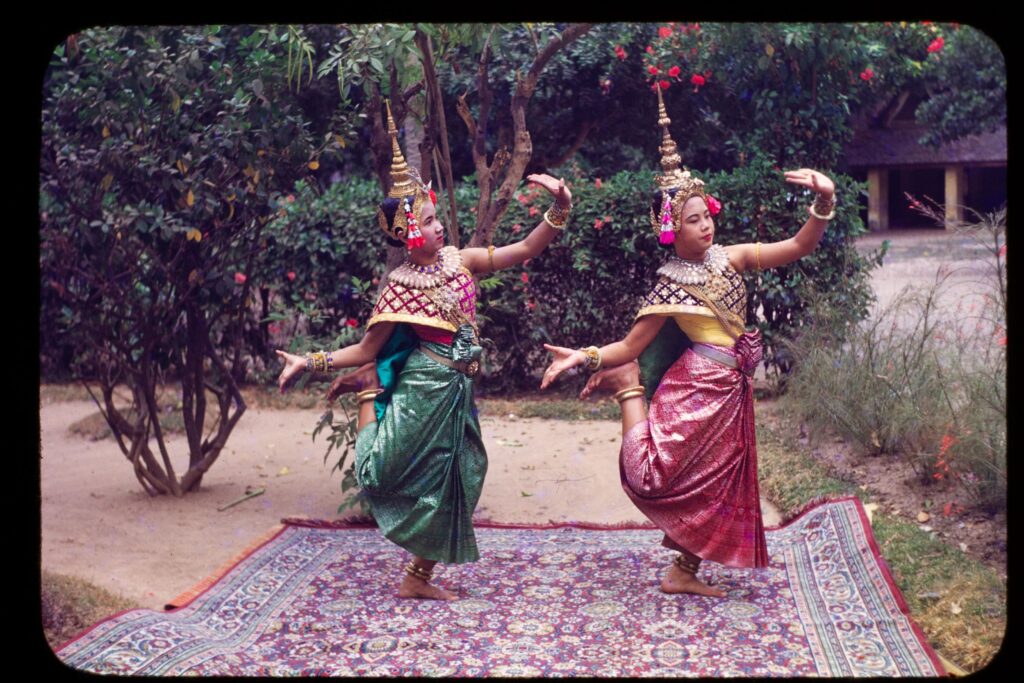
Ballet royal by Doan Van Ha
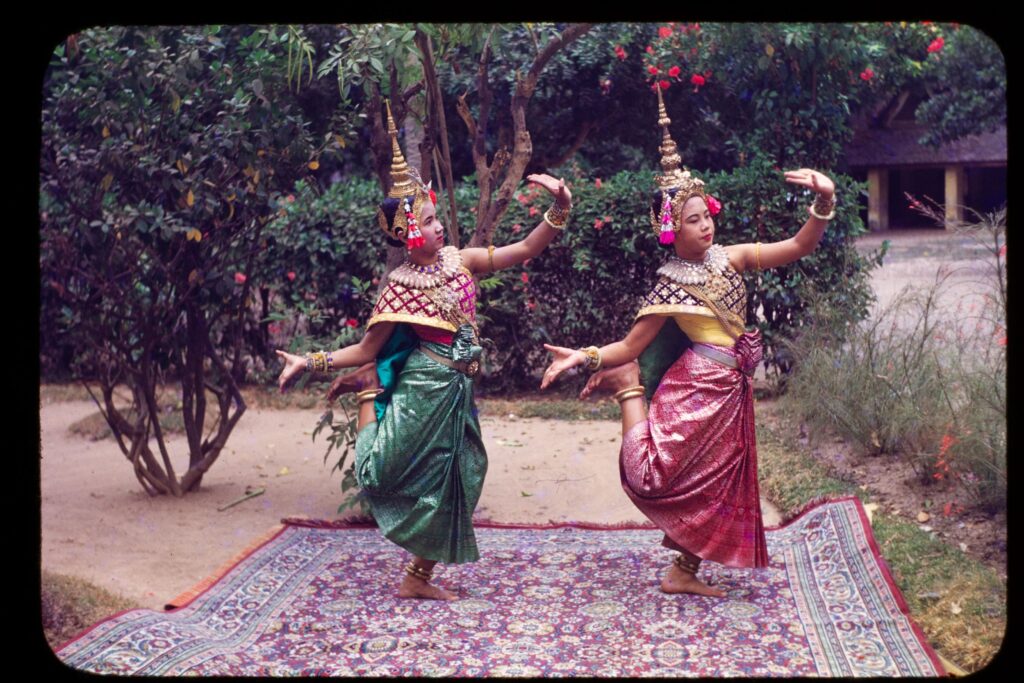
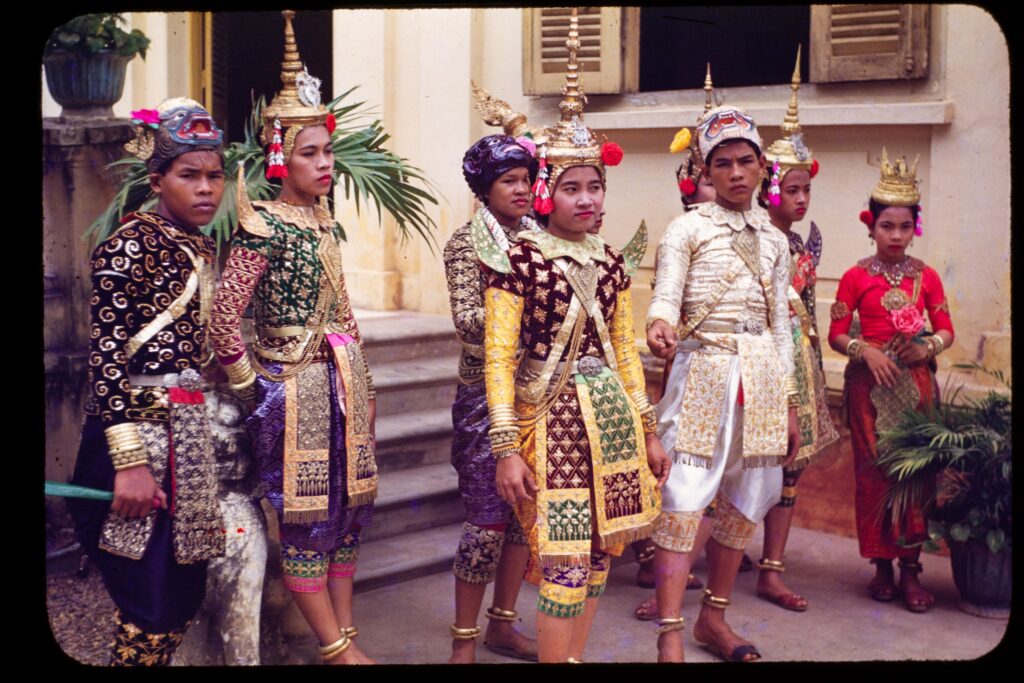
A-kong, this man who seems perpetually exiled, a little under or beyond our world, has always been discreet about his past. No matter how much I read and educate myself, for a long time I missed these little details, fragments of life, which now help me to better understand — accept? — the contradictions of my father and his times. Grandfather’s professional ties to the royal family beside his communist convictions. Today’s bloody Chinese national pride beside yesterday’s Khmer Rouge executioners armed by the PRC. My father’s courage as a survivor and his paranoia as a forgotten witness. On the benches of Baiyun airport’s Terminal 2, we take stock of our travels. Elly confides in me: « I don’t know. I’ve always had this feeling deep inside me that something was missing, but after this trip I finally feel whole. »
- A-kong means grandfather in the Min Nan Chinese dialect. ↩︎
- It took ten years (1997-2007) even to set up this special international tribunal. ↩︎
- There were five of us in all, my family and my elderly aunt and her son. ↩︎
- L’ami retrouvé, meaning the found friend, or found-back friend, is the French title of Fred Uhlman’s novel Reunion. I studied it as a teenager in the 12th arrondissement of Paris, and it was part of my college curriculum. It’s about the friendship between the son of a Jewish doctor and a young German aristocrat under Nazi rule. After the war, the Jewish son tries to find out what happened to his friend. Integrated on the outside, but still a foreigner on the inside, I identified a lot with him. ↩︎
- From the exhibition brochure The Journey of King Sisowath in France, A Mutual Revelation, Sosoro Museum, 2022. ↩︎
- Apsaras, meaning « those who glide on water », are Hindu deities. At the time of the Angkor kingdom, they were embodied by dancers who, through their costumes and sacred dances, reenacted ancient Khmer cosmogony. ↩︎